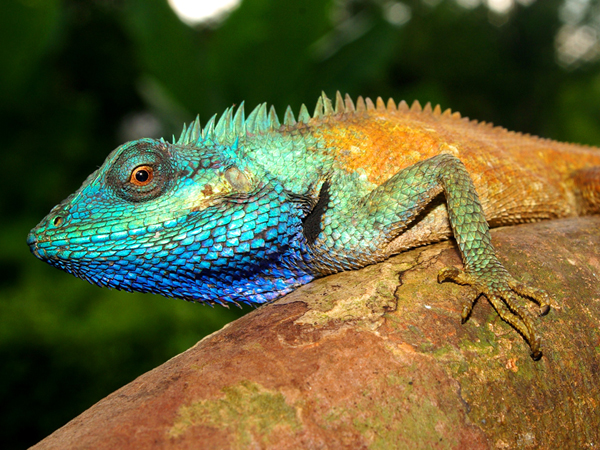Colorful New Lizard Identified in Vietnam
The colorful lizards can be spotted from far away, even in the deep Vietnamese rainforest.
Scientists have identified a new bright-blue lizard hiding in plain sight.
The lizard, found in Vietnam and named Calotes bachae, had long been thought to be another blue lizard species found in Myanmar and Thailand. A combination of genetic analysis and studying the size and scale characteristics of the animals revealed that the lizard belongs to a new species, according to an article in the January issue of the journal Zootaxa.
At first glance the new species looks more or less identical to another blue-headed lizard in Southeast Asia, Calotes mystaceus, said article lead author Timo Hartmann, and scientists had not taken a closer look until now.
During mating season, the colors of the male lizards—which can measure up to 11 inches (28 centimeters)—become especially vivid, ranging from cobalt blue to bright turquoise. This serves to attract females and to intimidate other males, said Hartmann.
While by day the lizard's blue and green coloration is striking, at night it appears dark brown, "showing no bright coloration at all," said Hartmann, a Ph.D. candidate at the Herpetology Department at the Museum Koenig in Bonn, Germany.
The newly identified animal was found in open areas of Cat Tien National Park, in dense tropical forests in Bu Gia Map National Park and, perhaps surprisingly, in parks in downtown Ho Chi Minh City.
The discovery grew out of a survey of reptiles and amphibians in Vietnam's Cat Tien National Park. Specimens from the project that were believed to be Calotes mystaceus were shared with Russian scientists working on a DNA barcoding database of all amphibian and reptile species from Vietnam.
Different Genes, Different Marks
The barcoding, which compares specific genetic markers, revealed a significant number of genetic differences between the previously known species and what is now known as Calotes bachae. The finding was unexpected, but not uncommon, said study co-author Nick A. Poyarkov, from the Department of Zoology of the Lomonosov Moscow State University in Moscow, Russia.
"In many cases two different species of frogs or lizards may look really similar but have profound genetic divergence," Poyarkov said.
Further research revealed that it's also possible to differentiate between the two species with the naked eye.
Calotes bachae has faint brown blotches on its back, along with a yellowish moustache-like marking on its face. The Calotes mystaceus, by contrast, has dark brown spots and a white moustache. The differences become especially apparent during mating season, Hartmann said.
Hartmann suspects the surprising discovery points the way to other yet-to-be-identified lizard species: "I am sure that in Southeast Asia in general there are still many more new lizard species to discover."
Katia Andreassi
National Geographic News
Published January 16, 2013












